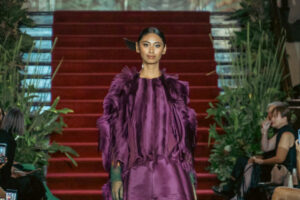By Joseph L. Garcia, Senior Reporter
STORMS could not dampen Dennis Lustico’s day. His 25th anniversary show, titled Pamana, was postponed by a typhoon about a month ago. On Oct. 3, Mr. Lustico went on with his show at the storied Goldenberg Mansion by the Malacañang complex, despite drizzles throughout the day.
Attended by the First Lady Marie Louise “Liza” Araneta Marcos, the fashion spectacle opened with a show of power, with members of the diplomatic corps walking the length of the mansion.
Ambassadors Constance See (Singapore), Laure Beaufils (the UK), MaryKay Carlson (the US), and Endo Kazuya (Japan) were among those who walked the runway (the ambassadors from Thailand, Malaysia, Norway, Egypt, Hungary, and Romania round out the list). Each wore a Filipiniana outfit made by Mr. Lustico — they were conservative, bearing in mind the stature of the wearer.
Mr. Lustico and event chair consul Agnes Huibonhoa have chosen Fashion Aid Philippines (FAP) as the beneficiary of the salon show/benefit. FAP is a non-profit which aims to “promote the cultural, social, and economic consciousness of the public” as well as help the new generation of Filipino designers and their accompanying industries: shoemaking, hair and makeup, and various other artisans in the clothing trade.
The real show began with a cocktail dress with a large collar — the silhouette is ’60s and Space Age, but the collar’s shape also calls back to the panuelo, the fichu draped over the native Filipina traje de mestiza dress.
The various outfits on the runway continued on the theme of reimagined Filipino: think a dress shaped like a barong, but puffed up here and there for something new. Sometimes, the effect isn’t immediately noticeable: there were dresses with 3D sprigs, embroidered or floating completely on a translucent piña outfit, which turned out to be various species of plants in the Philippines like anahaw and moringa. The theme, after all, was a celebration of heritage (the meaning of “pamana”). For the collection, Mr. Lustico used local fabrics such as abaca, piña, and other indigenous weaves from Luzon, Visayas, and Mindanao.
Mr. Lustico dedicated his time to collaborating closely with artisans from Aklan, Lumban, and the northern regions of Luzon, according to a statement. Distinctive patterns that follow the likeness of gumamela (hibiscus), kalabasa (squash) leaves and flowers were seamlessly integrated into fabrics woven exclusively for the show. According to him, thoughtful placement of patterns on sheaths of piña considered how the fabrics would be cut into contemporary garments. Lumban’s tradition of needlework was also celebrated, such as in the aforementioned embroidery of anahaw and moringa leaves.
Another part of the show was inspired by the stone houses of Batanes, where small wooden squares, each one individually cut and lacquered, were used to embellish tops and shift dresses. Fringe trimmings were also incorporated into his designs as a nod to the thatched roof of the bahay na bato, according to a statement.
The effect was stunning. The fringes were laid out in a certain way so that under the light, they all seemed to be moving in different directions, appearing like living, moving pixels that played with the eyes.
Another part of the show saw rich dresses such as in plum, silver, pink, and gold — strips of fabric were distressed to a point so they would be shaped like feathers: a strong central spine with soft “down,” appearing like soft, giant plumes that moved as the model walked. The effects were palpable: it made the show a multi-sensorial experience, the details seeming less that you could touch them, but more that they could come alive and touch you. Overall, it was a clever collection, worthy of its scale and its venue.
In a statement, Mr. Lustico said, “I was truly engrossed by the process. Everyday at the studio, I would be excited to see the outcome of each piece.
“When you honor the process and not rush things, you really learn so much from every garment,” he said. “When someone finds lasting connection with my designs or deeply relates to it, that’s when I know that I did a beautiful job.”
